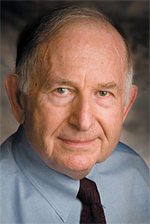Staying Out of Double Trouble

In this column I would like to address what I consider to be an "original sin" of television lighting.
It is so universal that it can be seen on nearly every show. The shot is supposed to be a simple, flattering single-viewpoint shot of a subject. Every news show is loaded with this common shot. Because of its simplicity, you would think that this shot would be a well-lighted portrait. Most of the time it is not!
For some reason, the subject is lighted from two lights—left and right—of equal intensity. The fixture can be of any type: two Fresnels with no diffusion, little diffusion or heavy diffusion; each with one-quarter CTO or not; two small, mid-size or large soft-lights and so on through the entire catalog of entertainment lighting fixtures.
The two fixtures always mirror each other in position and intensity. I can think of no reason why this practice has been so popular, but as far as I know it may have started at the birth of television broadcast (I was not there), or as early as the invention of the iconoscope, the pick-up tube used during the television broadcast of the 1939 World's Fair. Perhaps only the poor quality of the early images masked the method's poor result.

Fig. 1: Single high cross key Let's take a look at the approach. Fig. 1 shows a subject (guess who?) lighted by a single front light from one side from a moderately steep angle.
The shadows resulting from this light accentuate the contours of my face. Notice in particular the contrast of the "smile crease" and the vertical "chin line" on the camera-left side of my face. As if these shortcomings are not enough, the emphasis of the neck's contour is very unbecoming. No beauty shot here.
CROSS-KEY METHOD

Fig. 2: Double cross keys, high angle Now what if we add the mate on the other side to this setup? Fig. 2 shows the result of this addition. We now have the completed method. Shall we call it "The Cross-Key Method?"
Before you sit back and wait for the accolades to come your way, notice that we have now doubled the number of distorted surfaces that have too much emphasis and contrast. You could say that we have doubled the ugliness.
I hope you are suitably offended by the picture's appearance and would like to rant and rave about the wrong imposed on the subject. Notice also that one desirable effect missing because of the high angle of the two sources is the presence of a "glint" within the eyes from the front light.
Another disturbing result is the shadow on each shoulder, which could be very distracting, particularly if the reflectance of the clothing is high, as it is in this case. Also, the neck may take on a new life of its own and appear to be a separate appendage stuck onto the chin. In the absence of the "double chin" and a younger neck, the two front lights can create a triangular shadow under the chin that I like to call the "triangle of uncertainty."

Fig. 3: Double cross keys, low angleLET'S GET REAL
At this point, let me present some realism. Suppose you are caught in a situation of the "Press Conference" that we covered in this column's last appearance ("Where Did All Those People Come From?" TV Technology, May 1). Suppose there are a multitude of front camera positions and no available center front-light position, and we are forced to resort to the "Cross-Key Method."
Here is a suggestion to make the result somewhat more presentable: lower the height of the instruments. This may happen automatically if the room's ceiling height is limiting and the throw-distance long. This is illustrated in Fig. 3.
Note that there is some softening of the contrast. The double-nose shadow is unavoidable. The hope is that the subject will be facing either left or right the majority of the time rather than straight ahead. When facing one side, the front light on that side will look like a single front light with its mate assuming the role of a fill light whose intensity is slightly high. The double-nose shadow disappears, however, when the subject does not face center.
It is imperative that the two Cross Keys are offstage of the far camera on each side to eliminate a dark side. Nevertheless, it is a compromise that could not be avoided in this special case.

Fig. 4: Single key with fill But in the situation of the single-camera viewpoint pointed out at the beginning of this discussion, there really is no excuse for the use of the "Cross-Key Method" in this situation, as shown in Fig. 4.
Altering the intensity of one of the lights in the Fig. 3 setup shows an enormous improvement in the photography. All that was done was to clothespin a piece of diffusion over one lamp. The ratio between the intensities of the two units is about 3:1. The face is now nicely modeled, cleaner and easier to look at, and (screams of joy!) there is only one glint in each eye. The subject (same person), has a smoother look, but still retains some character. The shadow area is nicely transparent and we are not conscious of multiple sources.
Incidentally, I should point out that I purposely used "hard" sources in this illustration in order to make the shortcomings of the first three illustrations more apparent. The reason I mention this is that the adverse effects of the "Cross-Key Method" are more pronounced when using hard sources. So there is no misunderstanding, the use of, say, two identical soft lights will exhibit the same undesirable effects, less obvious, but still no more acceptable.
One last important point in connection with the simple single-camera shot: If you are unsure of your subject's features and wish to use the kindest and safest approach, then use a center-line main light, over the camera. In this case, I would suggest fill light to the left and right of the camera, slightly above lens height, this being the simplest, single way to avoid getting yourself into "Double Trouble."
Bill Klages would like to extend an invitation to all the lighting people out there to give him your thoughts atbill-klages@roadrunner.com
The professional video industry's #1 source for news, trends and product and tech information. Sign up below.
